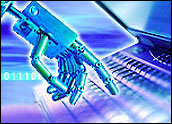
People can easily fold towels, but getting robots to do that has been a real challenge.
That’s because the robot requires a complex combination of artificial intelligence, computer vision and machine learning in order to make an orderly stack from a jumbled pile of towels, doctoral student Jeremy Maitin-Shepard told TechNewsWorld.
Maitin-Shepard is part of a research team at the University of California at Berkeley that developed software enabling a robot to fold a variety of towels that it had never before encountered.
The Robotic Towel Dance
Maitin-Shepard and Pieter Abbeel, an assistant professor in the university’s department of electrical engineering and computer sciences, led the team of four who carried out the project.
They used a prototype version of the PR-2 mobile robotic platform from Willow Garage as their platform.
The team, whose other members were Marco Cusumano-Towner and Jinna Lei, developed an algorithm that would let the robot fold towels it hadn’t seen before.
This is a breakthrough, as robots generally need to have encountered an object previously in order to “recognize” it. You can see the principle at work in antivirus software, which can defend against viruses whose signatures it has previously encountered but is impotent against newly developed malware.
The robot successfully folded towels that varied widely in appearance, material and size. The team will present a paper on its findings at the 2010 IEEE International Conference on Robotics and Automation in May.
The Project Details
The towel-folding robot grabs a towel, examines it, and folds it before stacking it in a predetermined location. Think of Mom folding the wash and stacking it on laundry day.
The team developed a grasp point detection algorithm that reliably detects the corners of a piece of cloth, in this case a towel, using only geometric cues. In other words, it lets the robot recognize which points of a towel it should grab when it looks at it and do so consistently.
Just as important, the team used a general-purpose robotic platform, meaning the robot didn’t have any specialized tools at the ends of its arms. In effect, that makes a general-purpose robotic platform a multipurpose tool, saving on the cost of building specialized robots for different tasks.
“Outside of carefully controlled settings, robotic capabilities are … limited,” the team’s paper notes. “The ability to even merely grasp a modest variety of previously unseen rigid objects in real-world cluttered environments is considered a highly non-trivial task.”
Handling non-rigid materials such as clothing is difficult, because their flexibility lets them assume different shapes, and their shapes change depending on how they are held.
Folding towels isn’t anywhere near as easy as it looks. The topology of non-rigid materials is much more complex than that of rigid ones, and the human brain performs complex calculations in coordination with the eyes and the hands in order to perform what we think of as a simple task.
It’s this hidden complexity that has stymied robotics researchers for years.
The team needed to incorporate artificial intelligence and coordinate it with computer vision and machine learning to enable the robot to reliably handle towels.
Next Paradigm Shift
What’s really striking about this project is that it was inexpensive and was completed fairly quickly, Eric Berger, director of the personal robotics program at Willow Garage, told TechNewsWorld.
“The thing that’s exciting about this towel-folding project isn’t the fact that we can fold bath towels, it’s that developing that new capability was faster and less expensive than it would have been before,” he explained. “It only required a graduate student with limited equipment instead of a multibillion dollar program.”
Berger attributed the low cost and the speed of development to the increasing power of personal computers.
“PCs have made it much easier to create startups and to do new things,” he pointed out.
“The increasing power of computers is helpful — a lot of the work in robotics can be done using simulators rather than hardware,” Maitin-Shepard said. “Willow Garage has developed a pretty sophisticated simulator for its PR-2 platform that’s accessible to everyone without needing the hardware.”
“We’ve already seen robotics being used in many ways before, most commonly in factory settings with closely controlled environments,” Maitin-Shepard said.
Personal robots will be the next paradigm-shifting personal productivity tool, Berger said. “By investing in open source and open platform adoption models, we aim to lay the groundwork for the use of personal robotics applications in everyday life.”





















































